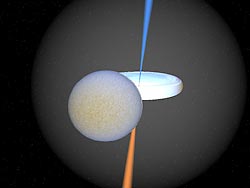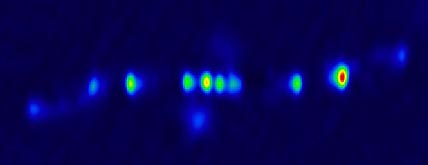For 25 years astronomers have been scratching their heads over the energetic binary star SS 433, a so-called microquasar in Aquila. And even though lots of new data were unveiled yesterday at the American Astronomical Society meeting now underway in Atlanta, Georgia, the experts are scratching their heads still.

In this artist’s schematic of SS 433, a hot, swollen star spills matter into a disk surrounding a superdense neutron star or black hole, with the disk’s glowing gases spiraling inward to that compact object — only to be cast off in narrow jets that blast into outer space at a quarter of the speed of light.
Courtesy Douglas Gies (Georgia State University).
Astronomers are keenly interested in SS 433 because it seems to be a miniature, million-times-scaled-down version of the engines that power quasars and other active galactic nuclei. This bizarre system consists of a fairly normal star and an extremely dense object — either a neutron star or a black hole — that orbit each other every 13 days. A stream of gas is spilling from the "normal" star into the dense companions's deep gravitational field, where it swirls into a hot, brilliantly glowing disk. Somehow, much of the material in the disk ends up within two narrow, oppositely directed jets that shoot away from the collapsed object at a quarter the speed of light.
That much has been known for years. But what type of star is fueling the disk and jets? And is the compact object a neutron star or a black hole?
In truth, no one knows. Two independent groups, using entirely different methods, have both concluded that the compact object is a black hole, but their mass estimates differ substantially, leaving a little wiggle room for the possibility that the object is a neutron star. The two groups also disagree about the donor star's mass.
One team, led by Georgia State University astronomers Todd Hillwig and Douglas Gies, imaged SS 433 in visible light with the 4.0-meter Mayall Telescope on Arizona's Kitt Peak. To avoid the accretion disk’s intense glare, the team observed the system at a critical juncture — when the star moves in front of the disk and eclipses its bright center. "This alignment only occurs twice per year," says Gies, because the system's orbital plane isn't parallel to our line of sight.

This false-color image from the continent-spanning Very Long Baseline Array (VLBA) shows where parcels of gas within SS 433's jets emit radio waves. The image spans 300 billion kilometers — the distance traveled by light in about 12 days. Click here for a 2.2 MB animated GIF showing a 42-day-long sequence of VLBA images — 'the most comprehensive and detailed movie of a microquasar,' according to team leader Amy Mioduszewski (National Radio Astronomy Observatory).
Courtesy NRAO.
The team succeeded in isolating the donor star's elusive light last October 2nd. Its spectrum closely resembles that of an evolved blue supergiant, which would make the donor star about 11 times as massive as the Sun. In turn, says the team, this implies that the collapsed object contains 3 solar masses, plus or minus about 50 percent. Theory dictates that a neutron star can bear the weight of only 2 or 3 solar masses before collapsing anew and becoming a black hole. Therefore, say Hillwig and Gies, SS 433's compact object is probably — but not definitely — a black hole.
However, another team, led by MIT astronomers Herman Marshall and Laura Lopez, announced a much higher mass estimate for the compact object — one that would place it firmly in the black-hole camp.
Marshall and Lopez's team took X-ray spectra of SS 433 over the course of a year with the Chandra X-ray Observatory. These spectra yielded a treasure trove of information about the jets, including its diameter (just 2,000 kilometers); a size and mass for the "normal" donor star (9.6 solar diameters and 27 solar masses, respectively); and a compact-object mass of 8 Suns.
"If you had to bet" on whether the compact object is a black hole or neutron star "before today, most astronomers would have refused the bet. But the odds are now tipping in the balance of a black hole," said independent commentator Bruce Margon (Space Telescope Science Institute), one of the astronomers who first called attention to SS 433’s unusual nature in the late 1970s. However, he cautions, "there is no smoking gun."
 0
0
Comments
You must be logged in to post a comment.